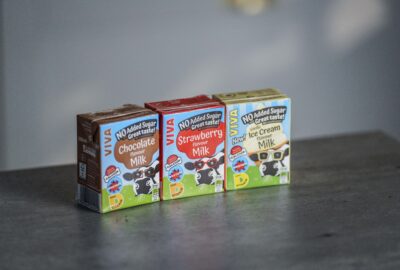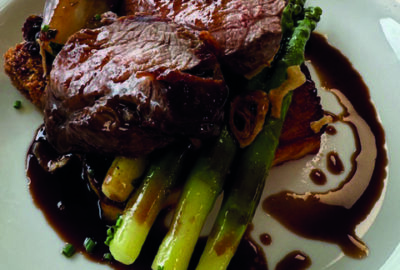The latest statistics show there are over 850,000 people living with dementia in the UK – a figure which is expected to rise to over a million by 2021. The number of people with dementia in Ireland is expected to more than double over the next 20 years, from 55,000 to 113,000 in 2036.
The condition is unique to each individual and often presents a variety of challenges when it comes to eating and drinking, from poor appetite to impaired cognitive ability and communication. It’s thought that around 50% of people affected by dementia experience problems with eating and drinking, known as dysphagia.
Power Lunch
As the risk of malnutrition increases with dementia, NICE (2018) guidelines recommend increasing protein, calories and nutrient density, and also trying finger foods, especially for those who have difficulties using cutlery.
“Add both protein and all-important fibre to the diet by mixing extra beans and sweetcorn into chilli con carne, together with a richly-flavoured sauce such as Mexican Adobo Hot Sauce stirred into the meat,” suggests Sarah Moor, brand manager for Lion sauces, from AAK Foodservice. “Offer leaner and lighter versions of cooked breakfasts that can be easily handheld, such as vegetarian sausages served in a soft white roll with ketchup or brown sauce.”
Sauces inspired by global cuisines can also revive memories of long-ago travel or childhoods spent in other parts of the world. Consider unfussy protein-based dishes livened up with flavours from Thailand, China, the Middle East or South America. Think about miniature pastries filled with minced meat and vegetables held together with Habanero Hot Sauce or a Maple & Bourbon BBQ Sauce; little fish tacos spiced up with a juicy cool salsa; or chicken arancini balls served with a soured cream and chive dip.
Vegetarians and Vegans
Meeting a resident’s needs is unique to that individual but there are steps that can be taken to give comfort to those with dementia. Amanda Woodvine, CEO at Vegetarian for Life, has helped support older vegetarians and vegans for around a decade.
“Those with dementia may experience a poor appetite, forget they have eaten, overeat or crave certain foods,” she says. “That is why at Vegetarian for Life we have launched our Memory Care Pledge to ensure vegetarians or vegans with dementia get the food and drink they need throughout their lifetime. We are encouraging care homes to pledge that they will help uphold residents’ choices for vegetarian or vegan living. An example of best practice could be that if a vegan resident were to accidentally choose a meat-based or non-vegan option, catering staff would do their very best to ensure that a plant-based alternative similar to the chosen dish would be offered.”
A trip Down Memory Lane
Gillian Hesketh is the MD of Happy Days, which designs creative resources and nostalgic displays for residential and care homes, hospitals and other settings which care for elderly people and people living with dementia. She creates reminiscence rooms, wall art and interactive materials to evoke memories in people living with dementia and provides activities to help prompt conversations with carers and family members. She recently completed the installation of two old fashioned corner shops at Lancaster Royal Infirmary, which include ‘pretend’ produce and vintage magazines for ‘customers’ to go and buy. Other projects include retro sweet shops, 1950s seaside murals, bus stops and train carriages – all installed within care settings.
“It’s about prompting people’s memories and bringing about stories from their past back,” says Gillian. “It can be difficult for family members to know what to talk about when they visit their loved ones but we are finding they are staying much longer when they have something that’s interactive that they can enjoy doing together.”
Nostalgic installations are also proving successful in care home dining rooms. For more information visit www. dementiaworkshop. co.uk
Reminiscence
Nestlé Professional has put together a reminiscence pack that uses some of the most beautiful items from its archive to create a versatile sensory experience.
The pack has been produced with advice from the Alzheimer’s Society, and includes tin labels, posters and wrappers from decades past, such as a Carnation tinned milk label. Alison Cook, of Alzheimer’s Society, said:“Even something as simple as an old sweet wrapper can bring back vivid memories from a happy time.”
The pack is available to download at https://www.nestle.co.uk/aboutus/history/reminiscence-pack
Meeting Nutritional Needs
Ensuring that the nutritional needs of people with dementia are met can be a challenge and many factors need to be considered including training and education, the mealtime environment, the use of nutritional supplements and the provision of assistance to eat.
Says Mark Taylor, foodservice customer controller at Premier Foods:
“Healthcare caterers have a key role in helping to reduce the risk of weight loss for people with dementia by providing a variety of different types of snacks and meals throughout the day to stimulate and motivate people to eat.”
Encouraging Appetite There are lots of ways to increase a person’s appetite and interest in food and drink. Knowing the person will help, as everyone has their own routines, preferences and needs. The Alzheimer’s Society recommends caterers:
- Use different tastes, colours and smells. The aroma of cooking, for example freshly baked bread, can stimulate someone’s appetite.
- Look for opportunities to encourage the person to eat. For example, if the person with dementia is awake for much of the night then night-time snacks may be a good idea.
- Give the person food they like. Try not to overload the plate with too much food – small and regular portions often work best.
- Food tastes may change, so try stronger flavours or sweet foods.
- Don’t stop someone eating dessert if they haven’t eaten their savoury meal. They may prefer the taste of the dessert.
- If food goes cold it will lose its appeal. Consider serving half portions to keep food warm. Use a plate warmer or a microwave to reheat food.
- If the person is having difficulties chewing or swallowing, try naturally soft food such as scrambled egg or stewed apple in the first instance, before considering pureed food.
- Encourage the person to get involved at mealtimes. They could help prepare the food or lay the table.
Top Tips
- Use strong and familiar flavours in dishes
- Presentation is important, we eat with our eyes and as loss of appetite is a key part of dementia, making food look appealing is vital. Use interesting layouts on plates as well as food of distinctive colours or shapes
- Those who tend to be more active but have a lack of concentration as a result of dementia require grab and go, snack-style foods that they can consume throughout the day. Finger food recipes, like the Paxo Crustless Quiche.


